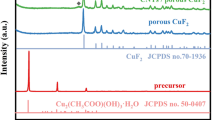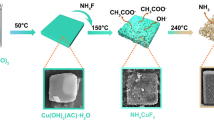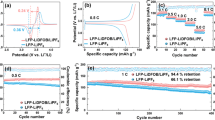Abstract
Anhydrous copper(II) fluoride (CuF2) has a high specific capacity of 528 mA h g−1 with an operating voltage of 3.55 V vs. Li/Li+, achieving a high gravimetric energy density of 1874 W h kg−1, which makes it a promising cathode candidate for next-generation rechargeable lithium (Li) batteries. However, the notorious dissolution of Cu during charging triggers the rapid failure of the CuF2 cathode, impeding its development. In this work, the reversibility of the anhydrous CuF2 electrode was enabled via the use of a fluorinated high-concentration (FHC) electrolyte to effectively suppress the dissolution of Cu. With the FHC electrolyte, the CuF2-Ketjen Black nanocomposite cathode delivered a reversible capacity of 228 mA h g−1 after 30 cycles, which nearly tripled that of the baseline electrolyte. Thus, the strategy of electrolyte engineering is proposed to harness CuF2 as a high-capacity cathode material for Li batteries.

摘要
无水氟化铜(CuF2)有望成为下一代锂电池正极材料, 其高比容量 (528 mA h g−1)和高工作电压(3.55 V vs. Li/Li+)使得其能量密度高达 1874 W h kg−1. 然而, 由于充电时铜的溶解, CuF2正极容易失活, 这限 制了其发展. 本研究采用氟化高浓电解液抑制铜的溶解, 从而实现了 CuF2正极的可逆循环. 采用氟化高浓电解液后, CuF2正极的容量在30 次循环后仍保有228 mA h g−1 是使用传统碳酸酯类电解液的电池容量 的近三倍. 综上, 本研究提出了一种电解质工程策略, 可以实现CuF2正 极的可逆充放电.
Similar content being viewed by others
References
Winter M, Barnett B, Xu K. Before Li ion batteries. Chem Rev, 2018, 118: 11433–11456
Wu F, Maier J, Yu Y. Guidelines and trends for next-generation rechargeable lithium and lithium-ion batteries. Chem Soc Rev, 2020, 49: 1569–1614
Sandstrom SK, Chen X, Ji X. A review of halide charge carriers for rocking-chair and dual-ion batteries. Carbon Energy, 2021, 3: 627–653
Zhang K, Hu Z, Tao Z, et al. Inorganic & organic materials for rechargeable Li batteries with multi-electron reaction. Sci China Mater, 2014, 57: 42–58
Liu Q, Wang Y, Yang X, et al. Rechargeable anion-shuttle batteries for low-cost energy storage. Chem, 2021, 7: 1993–2021
Krishnamurthy V, Viswanathan V. Beyond transition metal oxide cathodes for electric aviation: The case of rechargeable CFx. ACS Energy Lett, 2020, 5: 3330–3335
Chakraborty A, Kunnikuruvan S, Kumar S, et al. Layered cathode materials for lithium-ion batteries: Review of computational studies on LiNi1−x−yCoxMnyO2 and LiNi1−x−yCoxAlyO2. Chem Mater, 2020, 32: 915–952
Wang L, Wu Z, Zou J, et al. Li-free cathode materials for high energy density lithium batteries. Joule, 2019, 3: 2086–2102
Zou J, Yuan K, Zhao J, et al. Delithiation-driven topotactic reaction endows superior cycling performances for high-energy-density FeS (1 ≤ x ≤ 1.14) cathodes. Energy Storage Mater, 2021, 43: 579–584
Ke B, Wang X, Cheng S, et al. Ultrahigh-power iron oxysulfide thin films for microbatteries. Sci China Mater, 2023, 66: 118–126
Wu F, Srot V, Chen S, et al. 3D honeycomb architecture enables a highrate and long-life iron(III) fluoride-lithium battery. Adv Mater, 2019, 31: 1905146
Lai C, Chen K, Zheng Y, et al. Tailored deep-eutectic solvent method to enable 3D porous iron fluoride bricks for conversion-type lithium batteries. J Energy Chem, 2023, 78: 178–187
Chen K, Lei M, Yao Z, et al. Construction of solid-liquid fluorine transport channel to enable highly reversible conversion cathodes. Sci Adv, 2021, 7: eabj1491
Wu F, Srot V, Chen S, et al. Metal-organic framework-derived nano-confinements of CoF2 and mixed-conducting wiring for high-performance metal fluoride-lithium battery. ACS Nano, 2021, 15: 1509–1518
Hua X, Eggeman AS, Castillo-Martínez E, et al. Revisiting metal fluorides as lithium-ion battery cathodes. Nat Mater, 2021, 20: 841–850
Chen M, Zhao L, Li X, et al. Artificial cathode solid electrolyte interphase to endow highly stable lithium storage of FeF2 nanocrystals. Sci China Mater, 2022, 65: 629–636
Zhao X, Zhao-Karger Z, Fichtner M, et al. Halide-based materials and chemistry for rechargeable batteries. Angew Chem Int Ed, 2020, 59: 5902–5949
Hu J, Chen K, Yao Z, et al. Unlocking solid-state conversion batteries reinforced by hierarchical microsphere stacked polymer electrolyte. Sci Bull, 2021, 66: 694–707
Zhang Y, Meng J, Chen K, et al. Garnet-based solid-state lithium fluoride conversion batteries benefiting from eutectic interlayer of superior wettability. ACS Energy Lett, 2020, 5: 1167–1176
Maulana AY, Futalan CM, Kim J. MOF-derived FeF2 nanoparticles@ graphitic carbon undergoing in situ phase transformation to FeF3 as a superior sodium-ion cathode material. J Alloys Compd, 2020, 840: 155719
Hwang I, Jung SK, Jeong ES, et al. NaF-FeF2 nanocomposite: New type of Na-ion battery cathode material. Nano Res, 2017, 10: 4388–4397
Sun Z, Fu W, Liu MZ, et al. A nanoconfined iron(III) fluoride cathode in a NaDFOB electrolyte: Towards high-performance sodium-ion batteries. J Mater Chem A, 2020, 8: 4091–4098
Zheng Y, Zhang P, Wu SQ, et al. First-principles studies on the structural and electronic properties of Li-ion battery cathode material CuF2. Solid State Commun, 2012, 152: 1703–1706
Ji E, Huang J, Yu Z, et al. Electrochemical characterization of CuF2/CNTs cathode materials prepared by a coprecipitation method. Funct Mater Lett, 2022, 15: 2251036
Krahl T, Marroquin Winkelmann F, Martin A, et al. Novel synthesis of anhydrous and hydroxylated CuF2 nanoparticles and their potential for lithium ion batteries. Chem Eur J, 2018, 24: 7177–7187
Seo JK, Cho HM, Takahara K, et al. Revisiting the conversion reaction voltage and the reversibility of the CuF2 electrode in Li-ion batteries. Nano Res, 2017, 10: 4232–4244
Chun J, Jo C, Sahgong S, et al. Ammonium fluoride mediated synthesis of anhydrous metal fluoride-mesoporous carbon nanocomposites for high-performance lithium ion battery cathodes. ACS Appl Mater Interfaces, 2016, 8: 35180–35190
Hua X, Robert R, Du LS, et al. Comprehensive study of the CuF2 conversion reaction mechanism in a lithium ion battery. J Phys Chem C, 2014, 118: 15169–15184
Wang F, Robert R, Chernova NA, et al. Conversion reaction mechanisms in lithium ion batteries: Study of the binary metal fluoride electrodes. J Am Chem Soc, 2011, 133: 18828–18836
Cui YH, Xue MZ, Zhou YN, et al. The investigation on electrochemical reaction mechanism of CuF2 thin film with lithium. Electrochim Acta, 2011, 56: 2328–2335
Mansour AN, Badway F, Yoon WS, et al. In situ X-ray absorption spectroscopic investigation of the electrochemical conversion reactions of CuF2-MoO3 nanocomposite. J Solid State Chem, 2010, 183: 3029–3038
Wang F, Kim SW, Seo DH, et al. Ternary metal fluorides as high-energy cathodes with low cycling hysteresis. Nat Commun, 2015, 6: 6668
Huang Y, Zhang W, Li S, et al. Activate metallic copper as high-capacity cathode for lithium-ion batteries via nanocomposite technology. Nano Energy, 2018, 54: 59–65
Omenya F, Zagarella NJ, Rana J, et al. Intrinsic challenges to the electrochemical reversibility of the high energy density copper(II) fluoride cathode material. ACS Appl Energy Mater, 2019, 2: 5243–5253
Zhao Y, Wei K, Wu H, et al. LiF splitting catalyzed by dual metal nanodomains for an efficient fluoride conversion cathode. ACS Nano, 2019, 13: acsnano.8b09453
Xia J, Wang Z, Rodrig ND, et al. Super-reversible CuF2 cathodes enabled by Cu2+-coordinated alginate. Adv Mater, 2022, 34: 2205229
Zhao Q, Lu Y, Zhu Z, et al. Rechargeable lithium-iodine batteries with iodine/nanoporous carbon cathode. Nano Lett, 2015, 15: 5982–5987
Hashizaki K, Dobashi S, Okada S, et al. Suppression mechanism for dissolution of conversion-type CuCl2 electrode in LiPF6/methyl di-fluoroacetate electrolyte. J Electrochem Soc, 2019, 166: A568–A573
Li G, Duan X, Liu X, et al. Locking active Li metal through localized redistribution of fluoride enabling stable Li-metal batteries. Adv Mater, 2023, 35: 2207310
Geng L, Meng J, Wang X, et al. Eutectic electrolyte with unique solvation structure for high-performance zinc-ion batteries. Angew Chem Int Ed, 2022, 61: e202206717
Fang C, Ye Z, Wang Y, et al. Immobilizing an organic electrode material through π-π interaction for high-performance Li-organic batteries. J Mater Chem A, 2019, 7: 22398–22404
Dubouis N, Marchandier T, Rousse G, et al. Extending insertion electrochemistry to soluble layered halides with superconcentrated electrolytes. Nat Mater, 2021, 20: 1545–1550
Yang C, Chen J, Ji X, et al. Aqueous Li-ion battery enabled by halogen conversion-intercalation chemistry in graphite. Nature, 2019, 569: 245–250
Suo L, Hu YS, Li H, et al. A new class of solvent-in-salt electrolyte for high-energy rechargeable metallic lithium batteries. Nat Commun, 2013, 4: 1481
Hou LP, Li Z, Yao N, et al. Weakening the solvating power of solvents to encapsulate lithium polysulfides enables long-cycling lithium-sulfur batteries. Adv Mater, 2022, 34: 2205284
Su YS, Manthiram A. Lithium-sulphur batteries with a microporous carbon paper as a bifunctional interlayer. Nat Commun, 2012, 3: 1166
Huang C, Xiao J, Shao Y, et al. Manipulating surface reactions in lithium-sulphur batteries using hybrid anode structures. Nat Commun, 2014, 5: 3015
Cuisinier M, Cabelguen PE, Adams BD, et al. Unique behaviour of nonsolvents for polysulphides in lithium-sulphur batteries. Energy Environ Sci, 2014, 7: 2697–2705
Azimi N, Xue Z, Bloom I, et al. Understanding the effect of a fluorinated ether on the performance of lithium-sulfur batteries. ACS Appl Mater Interfaces, 2015, 7: 9169–9177
Tachikawa N, Yamauchi K, Takashima E, et al. Reversibility of electrochemical reactions of sulfur supported on inverse opal carbon in glyme-Li salt molten complex electrolytes. Chem Commun, 2011, 47: 8157–8159
Acknowledgements
This work was supported by the Fundamental Research Funds for the Central Universities and the Institute of Carbon Neutrality of Tongji University.
Author information
Authors and Affiliations
Contributions
Dai Y, Zhang R and Luo W conceived the idea. Huang Y, Liu X, and Wu W provided important experimental insights. Dai Y, Wang T and Song Z performed material fabrication and tests. Dai Y and Luo W co-wrote the paper. All the authors discussed the results and commented on the manuscript.
Corresponding authors
Additional information
Conflict of interest
The authors declare that they have no conflict of interest.
Supplementary information
Supporting data are available in the online version of the paper.
Yiming Dai received his BE degree from the East China University of Science and Technology in 2019. He is now a PhD candidate at the Institute of New Energy for Vehicles, School of Materials Science and Engineering, Tongji University. His research interest mainly focuses on conversion-type cathode materials for energy storage devices.
Renyuan Zhang received his PhD degree from Fudan University. He is currently a professor at the Institute of New Energy for Vehicles, School of Materials Science and Engineering, Tongji University. His research interest mainly focuses on energy storage materials, mesoporous materials, and nanomaterials.
Wei Luo is currently a professor at the School of Materials Science and Engineering, Tongji University. He received his PhD degree from Huazhong University of Science and Technology. Prior to his current position, he worked as a postdoctoral researcher at Oregon State University and the University of Maryland (UMD) until being promoted to assistant research professor at UMD. His research interests include solid-state batteries, liquid metals, and high-entropy materials.
Electronic Supplementary Material
40843_2023_2468_MOESM1_ESM.pdf
Enabling the reversibility of anhydrous copper(II) fluoride cathodes for rechargeable lithium batteries via fluorinated high-concentration electrolytes
Rights and permissions
About this article
Cite this article
Dai, Y., Liu, X., Wu, W. et al. Enabling the reversibility of anhydrous copper(II) fluoride cathodes for rechargeable lithium batteries via fluorinated high-concentration electrolytes. Sci. China Mater. 66, 3039–3045 (2023). https://doi.org/10.1007/s40843-023-2468-5
Received:
Accepted:
Published:
Issue Date:
DOI: https://doi.org/10.1007/s40843-023-2468-5




